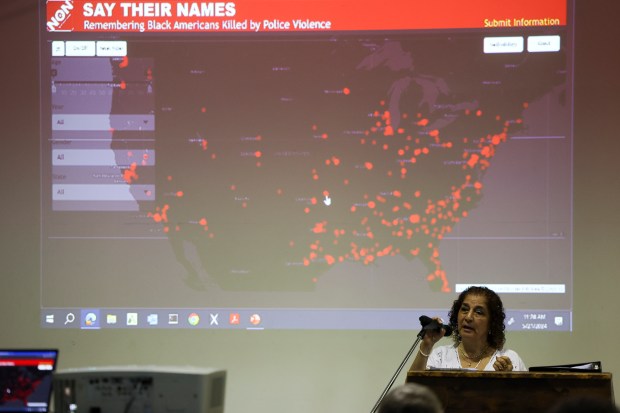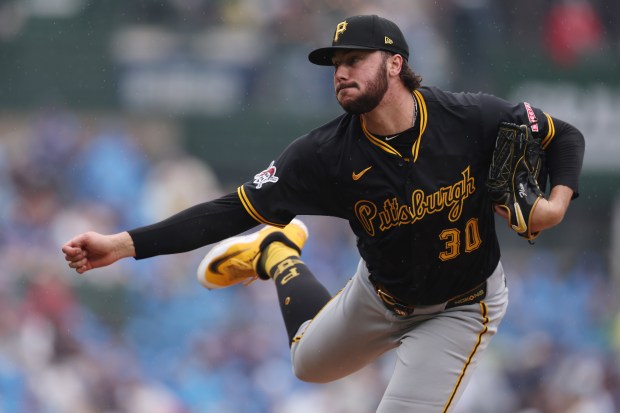A different kind of memorial project got underway ahead of the Memorial Day holiday, this one honoring the lives of Black Americans killed by police.
The “Say Their Names” initiative, which speaks the names of those whose lives were cut short, launched May 21. The interactive digital map is a database-fueled work that documents incidents that likely would not have resulted in death if white Americans had been involved in the same set of circumstances, said Ronald Browne, lead researcher of the project.
“It’s the story of Blacks in America … the fact that we are subjected to systemic racism,” Browne said. “We’re rapidly going back to the late ’40s and early ’50s, being seen as a target, the enemy … the police trace back to slave patrols. That’s where the attitude comes from.
“You’re someone to be contained: Atatiana Jefferson, Botham Jean, Breonna Taylor and Roger Fortson of the U.S. Air Force, all four of them were killed in their own homes,” Browne said. “A lot of this falls under basic racism. And the mainstream community, they don’t care. We hear people say they’re tired of hearing about race. Yes, well we’re tired of living it.”
By utilizing data from sources such as The Washington Post‘s police shootings database, and details culled from other newspapers, including the Chicago Tribune and the Sun-Times, the “Say Their Names” map showcases lives lost at the hands of law enforcement in the last decade. Browne and his team of about a dozen people aim to find, research, vet and post the names of the deceased from 1919 on, updating the site regularly to keep it current.
Browne pored over primary sources and cross-referenced details against obituaries and internet sources over the course of two years. And in doing the work, he was taken aback by the statistics he found. Black Americans make up about 14% of the U.S. population. But among those who were shot to death by police, Black Americans make up 26% of the population, according to Washington Post data from 2022, and that statistic increases further when it comes to unarmed Black people shot by police.
Browne said the idea for the project came after he saw artwork at Augustana Lutheran Church of Hyde Park in 2019 about 1919’s Red Summer race riots. In that exhibit, community members read the name, age, race and time, place, and manner of death of each person from July 27 to Aug. 5, 1919.
Looking over the Post’s database, Browne found 2,119 names of Black people who were killed and around 800 names were put on the map, with biographies and pictures of the deceased. Those who died in police custody are included and Browne said his team is looking at cases where police are called to scenes of mental health crises.
“We want to memorialize them and say, ‘Hey, these are people with lives,’” Browne said. He refers to the case of Tyre Nichols, who was going home when five police officers beat him to death.
“Those are the facts that most people concentrate on, but here’s a guy who was an amateur photographer, he had an infant son, and he was an avid skateboarder,” he said. “We humanize and memorialize each of the people that we feel are worthy to be on the site.”
Going forward, Browne envisions families, friends and colleagues reaching out to the “Say Their Names” team to submit images and details of those who should be added to the map, or more information added to those already featured on the website. Readers can also contribute to an ongoing audio installation, where the names, genders, ages, date of death, locations and cause of deaths of those killed are said in 20- to 30-second audio clips.
“Anybody from anywhere in the world can access it to learn about these lives,” said Saba Ayman-Nolley, the project coordinator.
Readers will not find details from police reports or mugshots on the map. “The focus is not on incidences of them having been killed or died. The focus is on the lives they were living that got unjustly shortened,” she said. “It’s an ongoing, evolving process, a true collaboration with the public. If we don’t have a photo and you happen to have a photo because you are a friend or a relative or you do your research independently and find a good photo to send us or some interesting, sweet thing about somebody’s life or a case you see that we don’t have on there, send it to us.”
Supported by grants from the Field Foundation, Illinois Humanities, and the Hyde Park and Kenwood Interfaith Council, “Say Their Names” is looking for more funding to keep the map up to date with the help of paid researchers, Ayman-Nolley said.
Knowing there are similar projects out there, Browne wants this new site to be as inclusive as possible, with no intention of diminishing the work of any other group. “We’re not in competition with anybody; we do like to think we’re a little bit unique with this interactive map. But if you ask, ‘Why is Johnny not on there?’ Well, tell us about Johnny. He might belong there,” Browne said.
Ayman-Nolley said Breonna Taylor’s case is the one closest to her heart. Taylor, a 26-year-old Black woman, was fatally shot in bed in her apartment in Louisville, Kentucky, during a botched raid by plainclothes narcotics detectives; no drugs were found, and the “no-knock” warrant used to enter her home by force was later found to be flawed. She died March 13, 2020.
“The system has to change. This cannot go on,” Ayman-Nolley said. “One of the reasons I was so insistent on doing this project is that cases like Breonna Taylor’s goes on for months and years before anything is done, meanwhile when police officers are on desk duty until it’s resolved, they continue to get paid. Meanwhile, the husband, the wife, the mother, the child of the person who got killed, they’re not getting paid, they lost somebody who was part of their family, who was a resource to the family.”
Ayman-Nolley said the memorial is not just an educational tool that can be used to start the healing in communities, but it can give voice to the voiceless.
“All of these people on the map don’t have a voice to say what their hopes and wishes were that got cut off. We have to be that voice. And we have to stand beside those family members so they don’t feel like their loved ones are forgotten,” she said. “We’re hoping to be able to connect to the families more effectively with this and to get them to realize this memorial exists for their own healing, but also we want them to look at it and tell us if there is something else we should say or something we’re saying they don’t want us to say.”




